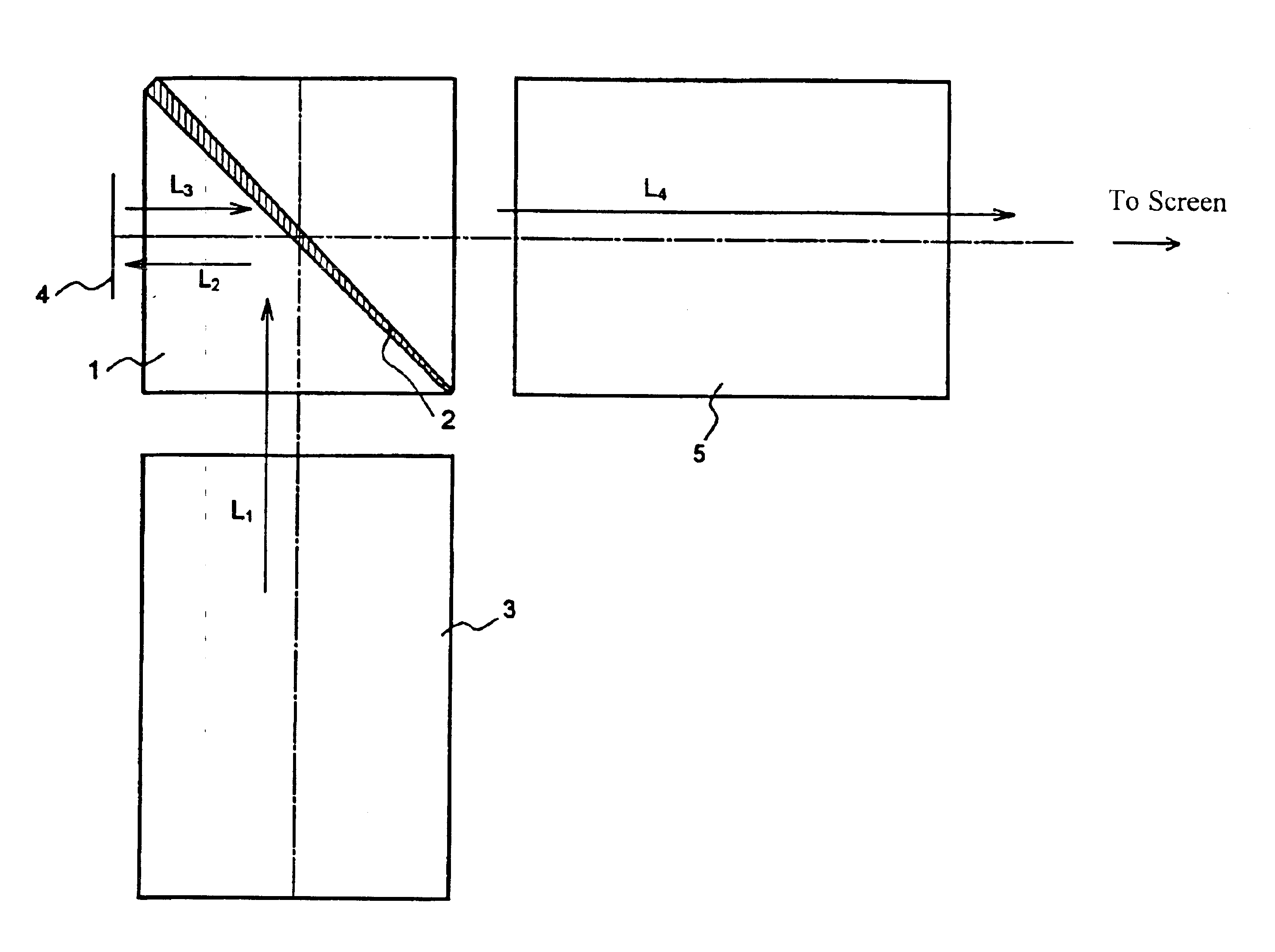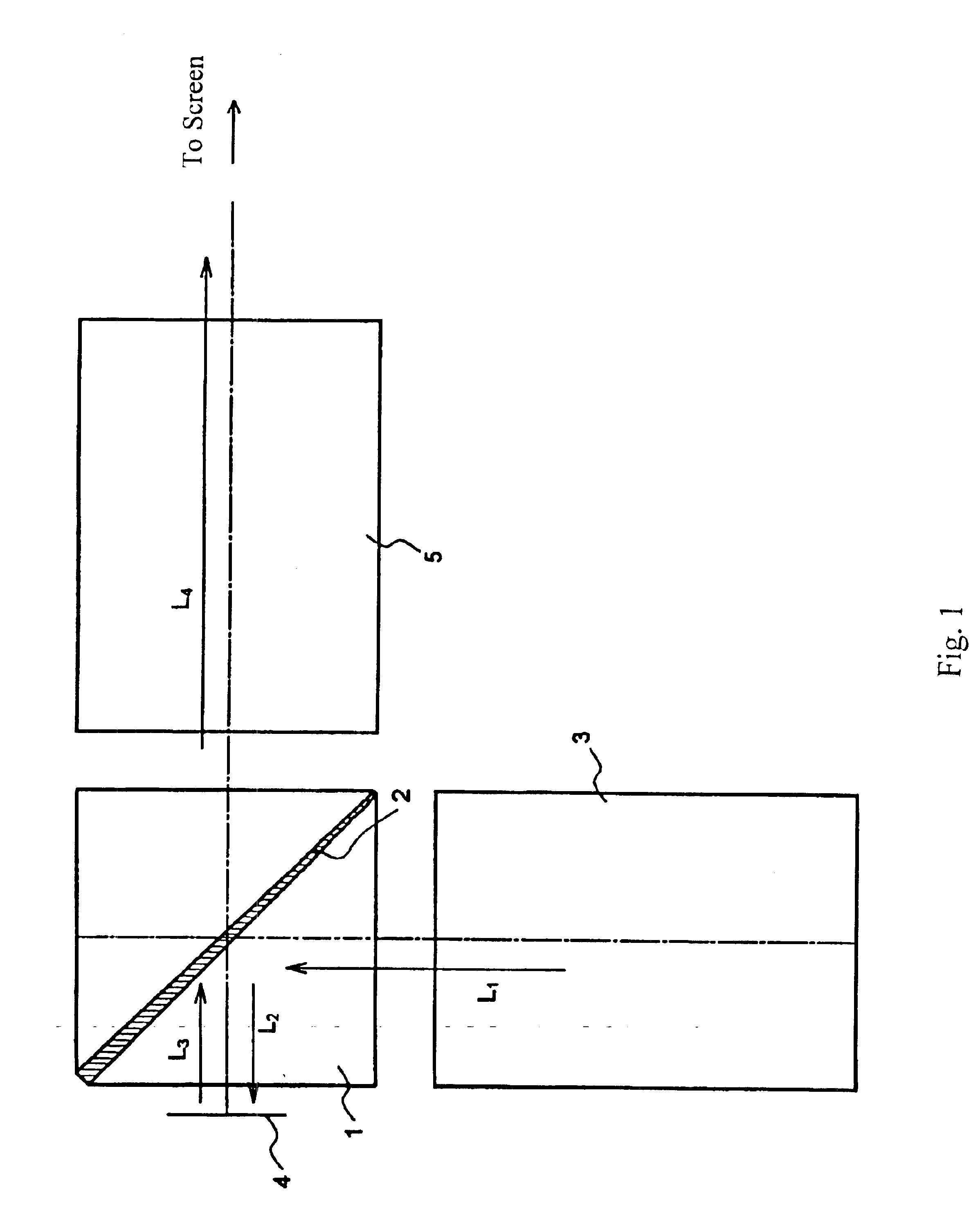Polarized beam splitter and projection-type image display using it
- Summary
- Abstract
- Description
- Claims
- Application Information
AI Technical Summary
Benefits of technology
Problems solved by technology
Method used
Image
Examples
embodiment 1
FIG. 1 shows a schematic cross-sectional view of a projection image display device of Embodiment 1. FIG. 2 shows an enlarged view of the PBS 1 shown in FIG. 1. The projection image display device includes a light source (not shown), an illumination optical system 3 including a time-sharing color separating system, a PBS 1 including a wedge-shaped intermediate layer 2 according to the present invention, an LCOS 4 as an image display element, and a projection lens 5. The lower surface of the intermediate layer 2 is inclined forty-five degrees relative to the incident light, and its wedge shape is such that the thick part of the intermediate layer 2 is located near the incident surface of light from the LCOS 4 and the thin part is located away from it. The PBS 1 satisfies Condition (1) above in which Np is the refractive index of the material of the two prisms forming the PBS 1 and Nc is the refractive index of the adhesive forming the adhesive layer of the intermediate layer 2.
Light L...
embodiment 2
FIG. 4 shows a schematic cross-sectional view of a projection image display device of Embodiment 2. The projection image display device includes a light source and an illumination optical system (not shown), a Philips prism 16, which is not polarization sensitive, as a color separating and combining device, a PBS 11 including a wedge-shaped intermediate layer 12 according to the present invention, LCOSs 14a, 14b, and 14c as image display elements, and a projection lens 15.
PBS 11 is nearly the same as PBS 1 of Embodiment 1 and, therefore, a detailed explanation of its structure is omitted here. The intermediate layer 12 is inclined by approximately forty-five degrees relative to the incident light. The thick part of the wedge shape is located near the incident surface of light from the LCOSs 14a, 14b, and 14c and the thin part is located away from the incident surface. The PBS 11 satisfies Condition (1) in which Np is the refractive index of the material of the two prisms forming the...
embodiment 3
FIG. 5 shows a schematic cross-sectional view of a projection image display device of Embodiment 3. The projection image display device includes a light source and an illumination optical system (not shown), a Philips prism 26, which is not polarization sensitive, as a color separating and combining device, PBSs 21a, 21b, and 21c including wedge-shaped intermediate layers 22a, 22b, and 22c, respectively, according to the present invention, LCOSs 24a, 24b, and 24c as image display elements, and a projection lens 25.
The PBSs 21a, 21b, and 21c are nearly the same as the PBS 1 of Embodiment 1, and therefore, detailed explanations of their construction is omitted here. The intermediate layers 22a, 22b, and 22c are inclined by approximately forty-five degrees relative to the incident light. The thick parts of the wedge shapes are located near the incident surfaces of light from the LCOSs 24a, 24b, and 24c and the thin parts are located away from the incident surfaces. The PBSs 21a, 21b, a...
PUM
 Login to View More
Login to View More Abstract
Description
Claims
Application Information
 Login to View More
Login to View More - R&D
- Intellectual Property
- Life Sciences
- Materials
- Tech Scout
- Unparalleled Data Quality
- Higher Quality Content
- 60% Fewer Hallucinations
Browse by: Latest US Patents, China's latest patents, Technical Efficacy Thesaurus, Application Domain, Technology Topic, Popular Technical Reports.
© 2025 PatSnap. All rights reserved.Legal|Privacy policy|Modern Slavery Act Transparency Statement|Sitemap|About US| Contact US: help@patsnap.com



